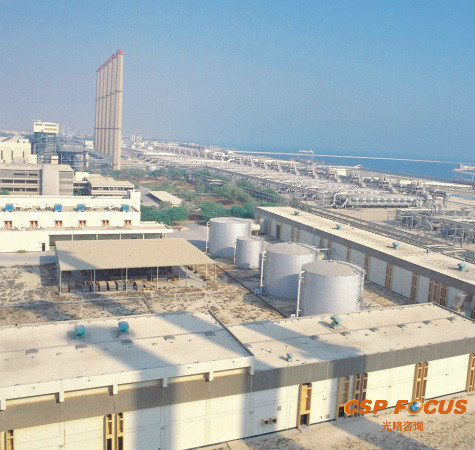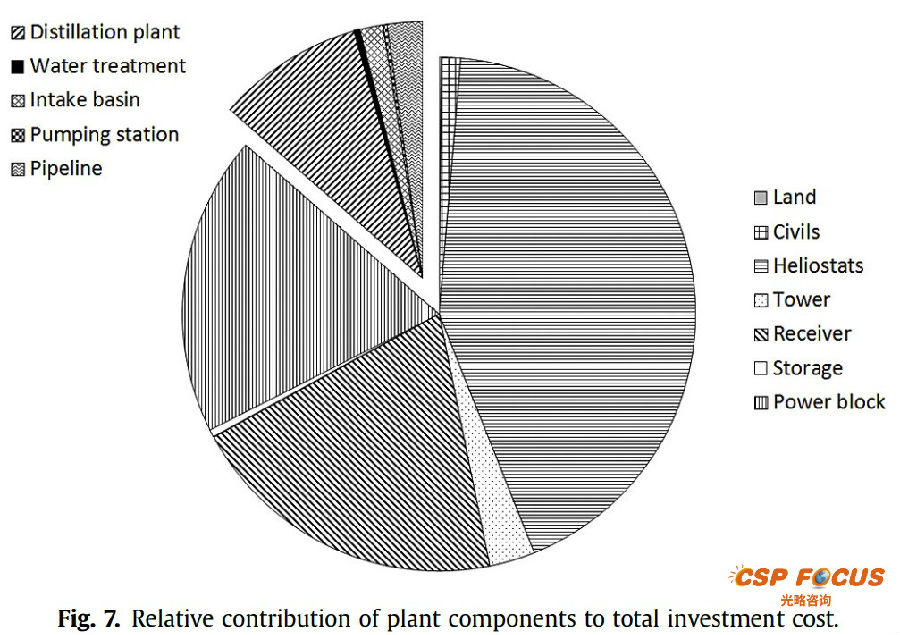Home > Market > Other Regions > Here
Concentrated Solar Power experts warn capex gains needed to ensure desalination future
2018.09.19 From: newenergyupdate.com
The U.S. Department of Energy (DOE) recently announced it would provide $21 million to 14 new solar thermal desalination projects which aim to reduce costs and open up the technology to new markets. The research projects cover a range of desalination technologies and are expected to take up to three years to complete. Elsewhere, researchers in Europe, Africa and the Middle East are continuing to optimize CSP designs for joint power and desalination purposes.
Developers believe solar thermal power with storage can provide cost-effective desalination services in solar-rich areas, reducing their reliance on fossil fuels. Smaller CSP plants could also provide desalination services in remote regions by removing the need for grid-connected power.
Key growth markets for desalination include municipal water production, agriculture, industrial processes and the purification of water produced during the extraction of natural resources. In solar-laden countries like Saudi Arabia, growing power demand and desalination needs present a major opportunity for CSP with storage.

Port Augusta, Australia – December 2, 2016: Southern Shorthaul Railroad’s (SSR) venerable Streamliner locomotives B61, GM27, S317, GM10 and S302 trundle their consist of empty coal wagons past the now de-commissioned Port Augusta power station with #4578 special coal wagon transfer from Port Augusta, SA to Lithgow in New South Wales. The freight cars will see service hauling coal or grain in NSW Hunter Valley.
The DOE’s latest R&D initiative has set a target of a levelized cost of water (LCOW) of $0.50 per cubic meter for large-scale plants that process high-volume, low salinity water such as sea water for a municipal utility. For small-scale plants that process low volume, high-salinity water, such as brine from oil and gas operations, the research projects must aim to achieve a LCOW of $1.50 per cubic meter.
Reverse osmosis is currently the most commonly-used process for desalination but CSP plants may be more suited to multi-effect distillation (MED) as it applies a series of steam-based heating procedures, Aris Bonanos, assistant professor of energy systems at the Cyprus Institute, said. Thermal desalination can also accommodate warmer, higher salinity seawater, which can interfere with reverse osmosis processes.
The Cyprus Institute developed MED-based CSP power and desalination plant designs for Mediterranean islands in a project co-funded by the European Union.
“Our findings indicate that the co-generation is technically feasible and profitable under some environmental (e.g. distance from coast, seawater salinity, etc) and financial conditions, Bonanos said.
Reverse osmosis technology is continuing to improve and cost reductions are required for the CSP power system as well as the MED element for the technology to be competitive, warned Ernest Dall, assistant engineer at Namibia’s NamPower and co-author of a recent economic study on CSP desalination.
“It is fundamental that the energy source is reliable, flexible and cheap…All in all, the capital costs of both [integrated] technologies must be reduced,” he said.
Co-generation need
A report by South Africa’s Stellenbosch University, co-authored by Dall, showed that a 100 MW CSP plant in Namibia, adapted to co-generate water via multi-effect distillation (MED), could be financially viable.
The CSP-desalination plant would be more expensive to construct and operate than the existing Trekkoppje 20,000 million cu m/year reverse osmosis plant, situated north of Swakopmund, but rather than consume electricity, it could supply power across peak evening periods, the study said. The plant could supply 15% of Namibia’s peak power demand, helping the country meet its target of generating 70% of power from renewables by 2030, it said.
Component costs of proposed Namibia CSP-desalination plant

Source: Study by Stellenbosch University: ‘Integrating desalination with concentrating solar thermal power, a Namibian case study.’ (2017)
The study focused on conventional steam Rankine cycles and recent research by the U.S. National Renewable Energy Laboratory indicates that solar thermal powered sCO2 Brayton cycles may be more efficient for CSP desalination purposes, Dall noted.
Cost efficient energy storage is key to maximizing the value of CSP power and desalination projects as it extends operation time into key evening demand periods, opening up multiple revenue streams.
CSP storage technology is set to advance rapidly in the coming years. CSP researchers are developing new high-temperature designs and introducing new storage mediums in a bid to increase efficiency.
Remote openings
New breakthroughs in CSP design could open up more remote siting opportunities for desalination projects which do not require electricity production.
The Saudi Technology Development and Investment Company (Taqnia) has shown CSP can be used to directly power the desalination process, bypassing the electricity stage, Wail Bamhair, CEO at Taqnia Energy, said.
The removal of the electricity block could reduce the total cost of the CSP plant by around 10%, Bamhair said.
Engineering constraints must be overcome to allow stand-alone CSP-based projects, Bamhair warned.
To avoid degradation of the boiler, 50% of the energy was supplied from a conventional boiler, he said.
Saudi power
Saudi Arabia is seen as a key potential market for CSP desalination projects. The kingdom’s demand for desalinated water is currently around 7.5 million cubic meters per day and water demand is expected to rise 30% between 2016 and 2030.
Saudi Arabia currently hosts 18% of the world’s desalination plant capacity, of which around 70% operates by burning fossil fuels to power MED or multi-stage flash distillation (MSF) processes. Saudi Arabia’s National Renewable Energy Program (NREP) has set a target of 9.5 GW of renewable energy capacity by 2023, including potentially 1 GW of CSP, as the country looks to diversify away from hydrocarbon resources.
ACWA Power’s position as a leading CSP and desalination developer and its growing links with China could accelerate advancements in co-generation projects.
ACWA Power is developing the giant 700 MW DEWA CSP plant in Dubai at a record-low tariff price of $73/MWh. Shanghai Electric, a major Chinese power company will manage the installation and China’s Silk Road fund recently agreed to acquire 24% of the project.
In June, ACWA Power and major EPC group China Energy Engineering Corporation (CEEC) agreed to explore joint investment opportunities in power generation and water desalination in the Middle East and Asia.
“The framework agreement will enable both companies to explore joint investment opportunities and cooperate on power generation and water desalination projects,” ACWA Power said.
Relevant CSP Conference: CSP Focus Innovation 2018(Oct.25-26, Xi'an, China.)
More from CSP Focus
NextAfDB approves $221m loan for 100 MW Redstone Concentrated Solar Power project in South Africa
South Korean CSP developer predicts 'competitive' bid in Chile
Chile to build a 1,007MW CSP-PV integrated solar power project
Industry Shares its Experience to Advance Next Generation CSP
New Way to Dry Cool Concentrated Solar Power Plants – with Underground Air
Leave your thoughts here
Reports(Member Only)
See more+-
CSP Focus Membership Proposals
We are now proposing CSP Focus Membership, hoping to better serve our members to keep pace with the latest updates of ongoing CSP projects worldwide, and to establish and maintain business relations with major shareholders of the projects. CSP Focus offers to Membership exclusive access to:1. Daily/Weekly update and analysis on CSP policies, projects, technologies, market trend and corporate relea
-
The Latest CSP Focus Monthly Update
Join CSP Focus Membership to Get the Latest CSP Focus Monthly Update December Edition.
-
CSP Project Monthly Update 2022 December Edition
CSP Focus is presenting CSP Project (China) Update 2022 December Edition.Detail report is available for CSP Focus Membership.
-
Presentations-CSP Focus China 2021
The Report is for CSP Focus Members only.
Upcoming Events
See more+-
12th CSP Focus China 2022
2022.04.21-22 Beijing
-
11th CSP Focus China 2021
2021.10.28-29 Beijing
-
10th CSP Focus China 2020
2020.10.22-23 Beijing, China
Project Updates
See more+-
Lanzhou Dacheng Dunhuang CSP Project
Asia Pacific-China,Operational,Parabolic Trough
-
Luneng Haixi 50MW Molten Salt Tower CSP Project
Asia Pacific-China,Operational,Power Tower
-
Dubai 950MW NOOR Energy 1 CSP+PV Project
MENA-UAE,Under construction,Power Tower
-
Power China Gonghe 50MW Molten Salt Tower CSP Project
Asia Pacific-China,Operational,Power Tower





